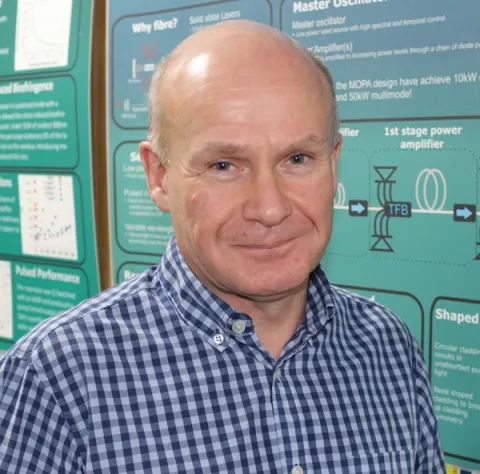About the project
High power fibre lasers (HPFLs), developed first at the University of Southampton, have advanced beyond recognition. Output powers have increased by more than four orders of magnitude in the past two decades, reaching 10kW in a single beam. They are widely used in the most advanced production lines for cutting, welding, 3D printing and marking a myriad of materials from glass to steel. However, we are now close to the maximum power that can be produced by a single fibre laser. To continue increasing the power, new solutions must be found.
Just as modern computers contain large numbers of processor cores rather than a single high-speed core, the future for HPFLs is in the combination of multiple fibre lasers. The successful combination of large numbers of fibre lasers would transform manufacturing. Such a breakthrough could enable control of all light properties (such as wavelength, polarization, intensity, and phase) to create dynamically reconfigurable structured light that changes “on the fly” depending on the specific application.
Such a “digital fibre laser” would not only make the UK a more prosperous nation, but also allow us to protect against malevolent drones, build the next generation of efficient, compact particle accelerators, clean-up space debris, treat nuclear waste, and all-in-all make the world a better, cleaner, greener, and safer place.
The University of Southampton has recently been awarded £6million to solve the challenges associated with the creation of the “digital fibre laser”, and you will be part of this team effort.
You will be leading the development of HPFLs in a range of novel wavelengths. The 2µm wavelength band (~1850 nm to ~2100 nm), the green wavelength band (~540 nm), and wavelengths in the UV band, offer the potential for huge benefits to industrial laser processing, due to enhanced absorption in a wider range of materials. These wavelengths offer the prospect of considerably enhanced precision and efficiency when processing and cutting a range of materials such as polymers, composites, and even biological tissue (e.g. for medical procedures). However, scaling average power in these wavelength regimes whilst maintaining high-quality beam profiles is a significant challenge.
You will be combining theoretical modelling with experimental work, to demonstrate a wide range of critically important breakthroughs, including multi-kW Tm fibre lasers with narrow-linewidths, and high-power green wavelength and UV lasers for composite materials processing for renewable technology applications.
